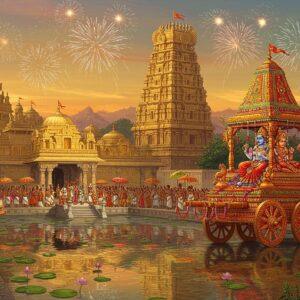Exploring Tridasha: The Cosmic Cycle in Hinduism

In Hindu philosophy, the concept of Tridasha embodies the continuous cycle of creation, preservation, and destruction, essential for cosmic harmony. This dynamic interplay is personified by the Hindu trinity: Brahma, Vishnu, and Shiva. Understanding this cycle provides insights into the universe’s balance and its reflection in our lives.
The Role of Creation (Srishti)
Brahma, the creator god, embodies ‘Srishti,’ or creation. His four heads symbolize the four Vedas, sacred texts offering profound wisdom about the universe’s origins. Hindu art and rituals often depict Brahma seated on a lotus, holding these sacred texts, reminding us of life’s genesis and the importance of knowledge. These depictions play a vital role in religious ceremonies, emphasizing creation’s sacred nature.
At poojn.in, we offer a wide range of products for your Brahma puja needs. You can find pure copper kalash for sacred water offerings, red flowers and garlands, authentic kumkum and roli for tilak, and brass bells for aarti.
The Role of Preservation (Sthiti)
Vishnu represents ‘Sthiti,’ or preservation. He maintains cosmic order and balance. His avatars, such as Rama and Krishna, restore harmony whenever it’s disrupted. Vishnu’s attributes, the conch and discus, symbolize his protective power. Stories from the ‘Dashavatara’ (ten avatars) offer profound lessons on maintaining balance and dharma (righteous conduct), influencing cultural practices that emphasize sustainability and harmony. These narratives remind us of our responsibility to protect and preserve the world around us.
You can find a variety of products for Vishnu puja, including Tulsi mala made from sacred basil, yellow cloth for deity decoration, pure ghee for deepak, and sandalwood paste for offerings at poojn.in.
Learn more about Vishnu, the Preserver.
The Role of Destruction (Samhara)
Shiva embodies ‘Samhara,’ or destruction, a crucial aspect of renewal. His dance, ‘Tandava,’ symbolizes the cyclical nature of destruction and recreation. Philosophically, destruction paves the way for new beginnings. Shiva’s trident and ash-smeared body symbolize the impermanence of life. Festivals dedicated to Shiva emphasize transformation, encouraging us to embrace change and renewal as essential parts of life.
Poojn.in provides a wide selection of items for Shiva puja, such as Rudraksha mala in various mukhi, white cloth for abhishek, pure copper vessels for jalabhishek, and bel patra leaves for puja.
Tridasha and Cosmic Balance
The interplay of creation, preservation, and destruction maintains cosmic balance. This cyclical nature, often depicted as ‘Kalachakra,’ illustrates the continuous flow of time. Understanding Tridasha helps us appreciate the universe’s dynamics and their impact on our lives. It encourages us to live in harmony with nature, emphasizing dharma or cosmic order. This ancient wisdom remains relevant today, reminding us of the interconnectedness of all things.
Embracing the Wisdom of Tridasha
Embracing the wisdom of Tridasha connects us to a timeless cycle. This eternal dance of creation, preservation, and destruction guides us towards harmony with nature and ourselves. By respecting these cosmic roles, we find balance in our own lives. We learn to value beginnings, nurture what we have, and accept endings as part of life’s natural rhythm. Tridasha reminds us that every ending is a new beginning, offering timeless wisdom for a balanced life.
Explore the many forms of Lord Ganesha.
What is the concept of Tridasha? Tridasha represents the cyclical nature of the universe through creation, preservation, and destruction. How does it maintain balance? It ensures harmony by the continuous interplay of these three forces. Which deities are associated with Tridasha? Brahma, Vishnu, and Shiva embody these cosmic functions. Why is destruction important? Destruction is essential for renewal and new beginnings, paving the way for creation. Can we observe Tridasha in daily life? Yes, the cycle manifests in natural processes like seasons, birth and death, and even personal growth. What’s the philosophical interpretation? Tridasha reflects the continuous flow of time and change, emphasizing the importance of balance. How is it depicted in mythology? Stories and texts illustrate the roles of Brahma, Vishnu, and Shiva, teaching valuable lessons about balance and transformation. Is it still relevant today? Absolutely. Tridasha’s principles encourage us to embrace change, seek balance, and recognize interconnectedness. Discover more about Goddess Lakshmi.


